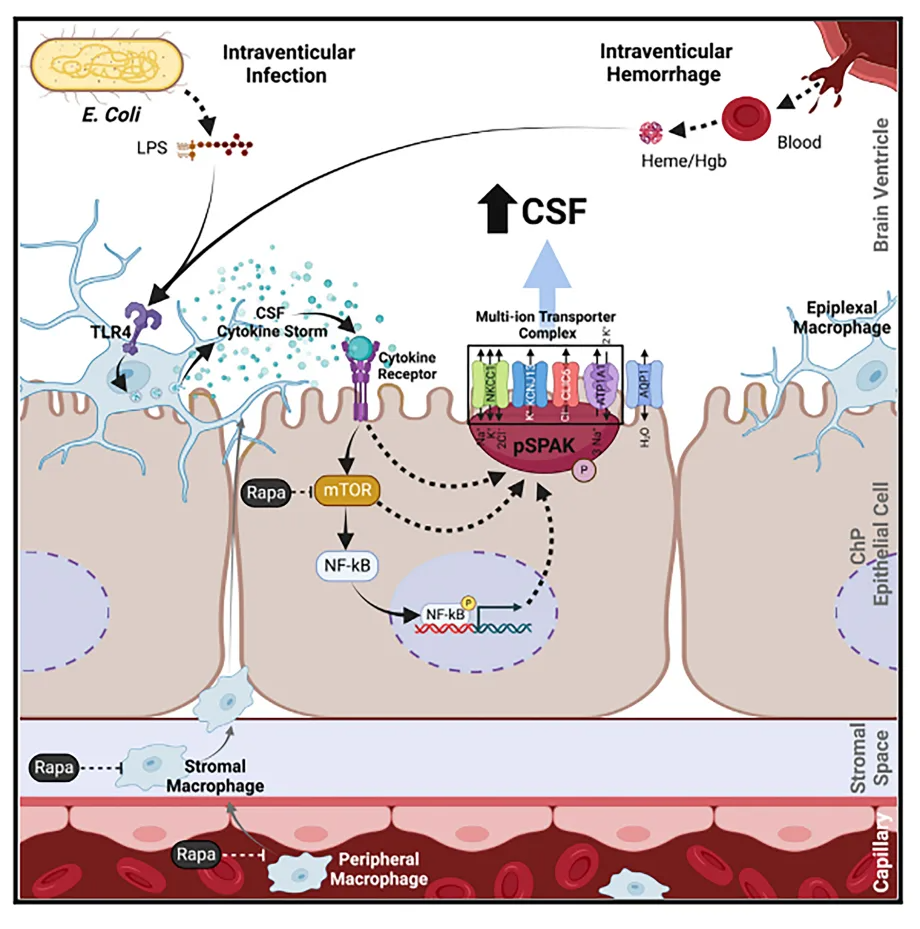Researchers Identify Crucial Link Between Immune System and Development of Acquired Hydrocephalus
Researchers in the Department of Neurosurgery at Yale School of Medicine have discovered the immune-mediated pathobiological process underlying two common types of acquired hydrocephalus.
Researchers in the Department of Neurosurgery at Yale School of Medicine have discovered the immune-mediated pathobiological process underlying two common types of acquired hydrocephalus. These findings shed fresh light on interactions between the brain and peripheral immune system and open new doors to the non-surgical management of this disease.

Graphical Abstract
Infectious and hemorrhagic hydrocephalus converge on highly similar immune and secretory responses at the choroid plexus that drive pathological cerebrospinal fluid secretion, thus opening up immunomodulation as a potential non-surgical intervention
Hydrocephalus is one of the most common conditions neurosurgeons treat. Although many forms of this pathology are congenital, many patients develop acquired hydrocephalus after either intracranial hemorrhage or infection. Accumulation of cerebrospinal fluid (CSF) in the brain's ventricles causes harmful pressure on surrounding tissue, leading to brain damage, altered mental status, coma, and, ultimately, death.
Currently, both post-hemorrhagic and post-infectious hydrocephalus treatment requires invasive neurosurgical intervention, often with a ventriculoperitoneal shunt. During this surgical procedure, a catheter is placed into the brain's ventricles to provide an alternative drainage pathway for CSF into the abdomen. While effective, shunt infection is common, and nearly 40 percent of shunts fail, requiring replacement within the first ten years.
In a study published in Cell, titled "The choroid plexus links innate immunity to CSF dysregulation in hydrocephalus," researchers used novel rodent models to explore the response of the choroid plexus, a highly vascularized secretory tissue in the brain's ventricles responsible for producing CSF, to infection and blood. They identified that intraventricular infection and hemorrhage trigger a strikingly similar immune response within the choroid plexus. Furthermore, they found that this immune-mediated reaction catalyzes the choroid plexus to produce more CSF than usual, ultimately leading to fluid accumulation and hydrocephalus.
"The work is significant for two reasons," says lead author Stephanie Robert, MD, Ph.D., chief neurosurgery resident at Yale School of Medicine. "It demonstrates that post-hemorrhagic and post-infectious hydrocephalus have a common underlying pathophysiology mediated by the choroid plexus, and it identifies the peripheral immune response as an important key component of this pathobiological response."
This work also revealed that a clinically available immunosuppressant drug, rapamycin, when administered systemically, prevented the development of hydrocephalus in both infectious and hemorrhagic hydrocephalus models.
"The choroid plexus remains an understudied area of the brain and its precise function as a brain barrier remains elusive," says senior author Kristopher Kahle, MD, PhD, adjunct professor of neurosurgery at Yale School of Medicine, director of pediatric neurosurgery at Massachusetts General Hospital, and director of the Harvard Center for Hydrocephalus and Neurodevelopmental Disorders. "Not only does this work uncover a similar and novel inflammatory mechanism driving these two common forms of acquired hydrocephalus, but it also demonstrates that by targeting the peripheral immune system with systemic immunomodulation, we are able to modulate the choroid plexus response and decrease CSF hypersecretion leading to hydrocephalus." These findings open new avenues for developing pharmacological treatments for certain forms of acquired hydrocephalus and may lead to better, non-invasive treatment options for these patients.
Publication: Stephanie M. Robert, et al., The choroid plexus links innate immunity to CSF dysregulation in hydrocephalus, Cell (2023) DOI: 10.1016/j.cell.2023.01.017
Original Story Source: Yale University

 Alerts Sign-up
Alerts Sign-up